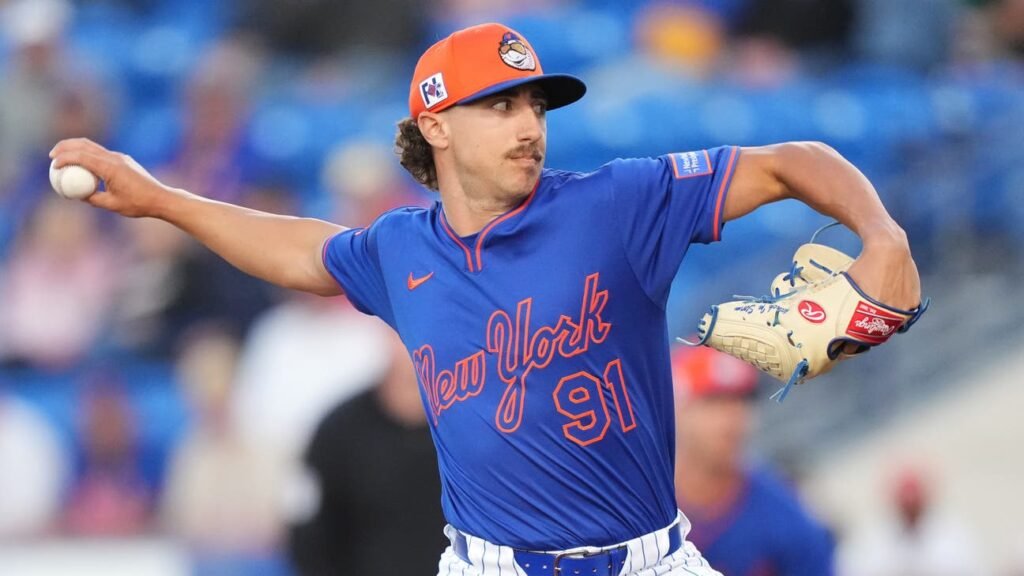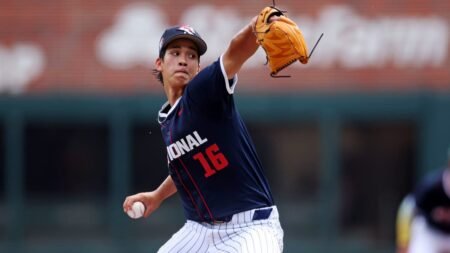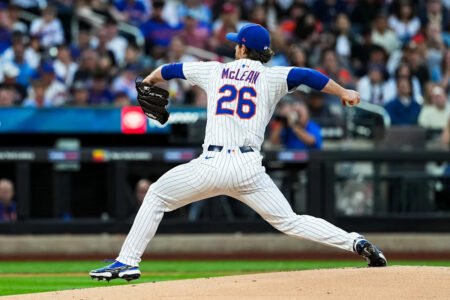Last week, the Mets called up No. 4 prospect Nolan McLean for his big league debut, and he impressed with 5.1 scoreless innings against Seattle. This has led to the question of "who’s next?"
There is likely just one more prospect who should be expected to debut during the 2025 season: No. 5 prospect, right-hander Brandon Sproat.
It’s been somewhat of a roller coaster ride for Sproat, who — less than a year ago — was the consensus Mets No. 1 prospect and was ranked among the top 50-60 prospects in all of baseball. It now appears as if that ride is soon going to arrive at the station, Willets Point that is.
Sproat burst onto the scene last year in his first professional season after the Mets took him in the second round of the 2023 MLB Draft.
In 17 starts split between High-A Brooklyn and Double-A Binghamton, he was basically untouchable, posting a 2.05 ERA in 87.2 innings with 110 strikeouts. Batters only hit .170 with a .523 OPS against him. He was blowing hitters away with his upper 90s fastball and leaning on a changeup and sweeper as his primary secondary offerings.
Then came his first real adversity as a professional at the Triple-A level. He made his first start with Syracuse on Aug. 8 against Worcester and allowed six runs on seven hits in 4.2 innings with three walks and four strikeouts. Sproat ended up making seven Triple-A starts to close out 2024 and posted an unsightly 7.53 ERA. Triple-A opponents hit .313 with a .957 OPS against him.
Adversity is not a bad thing. In fact, it is something the Mets organization embraces, as senior vice president of player development Andy Green told us on The Mets Pod back in spring training.
"[Adversity] is going to come in a big league uniform at some point in time, and you can always go back to that experience in the minor leagues," Green said. "We would love for everyone to have to fight through something."
Some of that adversity was due to challenges at the Triple-A level that affect some more than others. They use the major league ball there, and it is a different ball than Double-A and below. That generally has a negative impact on pitch metrics.
There is also the ABS challenge system, so pitchers must be more precise. On top of those changes, pitchers are facing veteran players, sometimes as much as 10 years older than them, who have much more of a plan at the plate.
The Mets were excited about Sproat’s spring training and his approach heading into this season, but it did not go according to plan for his first 15 outings. In 62 innings, Sproat posted a 5.95 ERA and struggled to miss bats, striking out only 43, which is a well below average 15.4 percent strikeout rate.
From a pitch usage standpoint, Sproat appeared to be focusing on trying to be a ground ball pitcher, with a higher use of his sinker. He was throwing it 21 percent of the time during that stretch after throwing it just one percent of the time in 2024. Overall, his power stuff wasn’t quite as powerful as it was in 2024.
His four-seam fastball’s average velocity was down nearly a full mile per hour, from 96.7 mph in 2024 to 95.9 mph in early 2025. It wasn’t just his fastball; his velocities were down across the board.
There was some thought that Sproat was not throwing with conviction and trusting his stuff like he should. He was pitching much more defensively, just trying to outsmart hitters instead of attacking them.
In late June, there was a mental shift from Sproat. He decided, after conferring with his mental strength coach as well as the Mets organization, that he was going to just let everything loose and throw the ball nearly as hard as he could. In his eyes, there was no downside.
In nine starts since, Sproat has pitched to a 2.05 ERA in 48.1 innings with 57 strikeouts. In this span, his 30.3 percent strikeout rate was essentially double what it was earlier in the year. Opponents have hit only .144 with a .461 OPS against Sproat over the last nine starts.
For Sproat, everything has taken a step forward in the last nine starts.
He is throwing more strikes, getting more swings and misses, his ground ball rate is up and, importantly, his line drive rate has gone down significantly. His average velocities and/or whiff percentages are up across the board for all six of his offerings from just earlier this season:
– Four-seam fastball velocity is up from 95.9 mph to 97.1, and whiff percentage is up from 18.1 percent to 32.1
– Changeup whiff rate is up from 27.8 percent to 40.6
– Sinker velocity is up from 95.3 mph to 96.1
– Slider velocity is up from 86.9 mph to 90 mph, and whiff rate is up from 20.7 percent to 24.4
– Sweeper whiff percentage is up from 31 percent to 38.6
– Curve ball velocity is up from 78.9 mph to 81.1 mph, and whiff percentage is up from 27.8 percent to 34.3
Sproat is pitching with confidence and conviction, and his stuff has ticked up across the board. He is back to routinely touching 99-100 mph, which he was not doing at all earlier in the season.
The Mets' rotation has been struggling for much of the second half, and Sproat has made the necessary adjustments that warrant a call-up.
Having both McLean and Sproat in the rotation could provide a jolt that the Mets seem like they need as they head into the final month of the season — as they try to make the playoffs for the second year in a row for just the third time in franchise history.
Read the full article here














